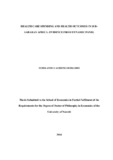| dc.description.abstract | This thesis addresses two issues. First, to address the problem of underfunding of health systems
in SSA the Abuja Declaration of 2001 set a target to allocate 15% of a country’s budget to public
health expenditure. However there is no empirical evidence on whether SSA countries are
converging or diverging from the target and whether there is significant effect of the Abuja
instrument on other health expenditure indicators. The second issue concerns health expenditure
and health outcomes. Although increased health expenditure has been widely advocated as a mean
to improve health status of the SSA population, empirical evidence to support this is scarce and
contains mixed findings. A key omission in this literature is lack of consideration of the institutional
environment in which health spending is undertaken. The primary objective of this thesis is to
examine the behaviour of health expenditure and its effect on health outcomes in SSA. First, the
thesis tested convergence of health expenditure in SSA in the post Abuja declaration period.
Second, the effects of health expenditure, level of corruption and their interaction on child health
and adult health were estimated. The linear dynamic panel model was estimated by GMM-IV
method on a panel of 41 SSA countries for the period 2000 to 2011. The thesis provides two sets
of econometric evidence. First, the empirical results show evidence of absolute and conditional
convergence of health expenditure in SSA. Differences in real income per capita aided convergence
of public health expenditure as a percent of government expenditure and private health expenditure
as a percent of total health expenditure but contributed to divergence of real per capita health
expenditure, total health expenditure as a percent of GDP and public health expenditure as a percent
of total health expenditure. Variations in external funding (donor) for health care caused divergence
in real per capita health expenditure, total health expenditure as a percent of GDP but aided the
convergence of public health expenditure as a percent of total health expenditure. Non-HIPC debt
relief benefitting countries were likely to diverge from equilibrium of total health expenditure as a
percent of GDP, public health expenditure as percent of government expenditure, real per capita
health expenditure and private health expenditure as a percent of total health expenditure except
for public health expenditure as a percent of total health expenditure. The Abuja policy instrument
(public health expenditure as a percent of government) reduced the rate of convergence of other
health expenditure measures except for private health expenditure as percent of total health
expenditure which was increasing in the study. Second, the study results indicate that health
expenditure significantly reduces under-five mortality and adult mortality in SSA countries. Public
health expenditures have significant negative effect on under-five mortality and positive effect on
adult mortality. The converse was found for private health expenditures. The quality of governance
proxied by corruption perception index had an impact on effectiveness of health expenditure in
reducing under-five and adult mortality. Public health expenditure was more effective in reducing
under-five mortality in low corruption environment than in highly corrupt environment. Private
health expenditure was more effective in reducing adult mortality in low corruption situation than
in high corruption environment. There also exist regional variations in effectiveness of health
expenditure and governance on under-five and adult mortality. In addition to health expenditure,
real income per capita, measles immunization rates and female labour force participation have
significant negative effect on under-five mortality. On the other hand, total fertility rates, female
literacy, HIV prevalence rates and ethnic fragmentation increased under-five mortality in SSA.
Real income per capita and adult literacy reduced adult mortality while, HIV prevalence rates and
ethnic fragmentation increased adult mortality. All the results exhibited significant differences
between Eastern Africa, Western Africa, Central Africa and Southern Africa. The implications of
the findings are: First, continued reliance on donor funding for health systems directly or through
debt relief is likely to delay convergence to Abuja target. SSA governments should formulate
sustainable health financing mechanisms that reduce dependency on external source for health
system support in the long run. Second, for increased health expenditure to yield greater reduction
in mortality it should be accompanied by improvements in governance through reduced levels of
corruption. This points to the importance of enhancing anti-corruption efforts to improve
effectiveness of health expenditure in improving health outcomes in SSA. Third, the regional
differences in effectiveness of health expenditure, provides an impetus to formulate joint
coordinated policies to regulate institutional environment for SSA health systems. This is likely to
improve implementation of common health agendas such as, Abuja Declaration 2001 and the
Ouagadougou Primary Health Care Framework of 2008 within SSA countries. Policies to increase
real income per capita, measles immunization, female labour force participation and ethnic
cohesion and policies to lower fertility rates and HIV prevalence rates would reduce under-five
mortality rates. Adult mortality could be reduced by policies that increase ethnic cohesion, real
income per capita and adult literacy | en_US |

